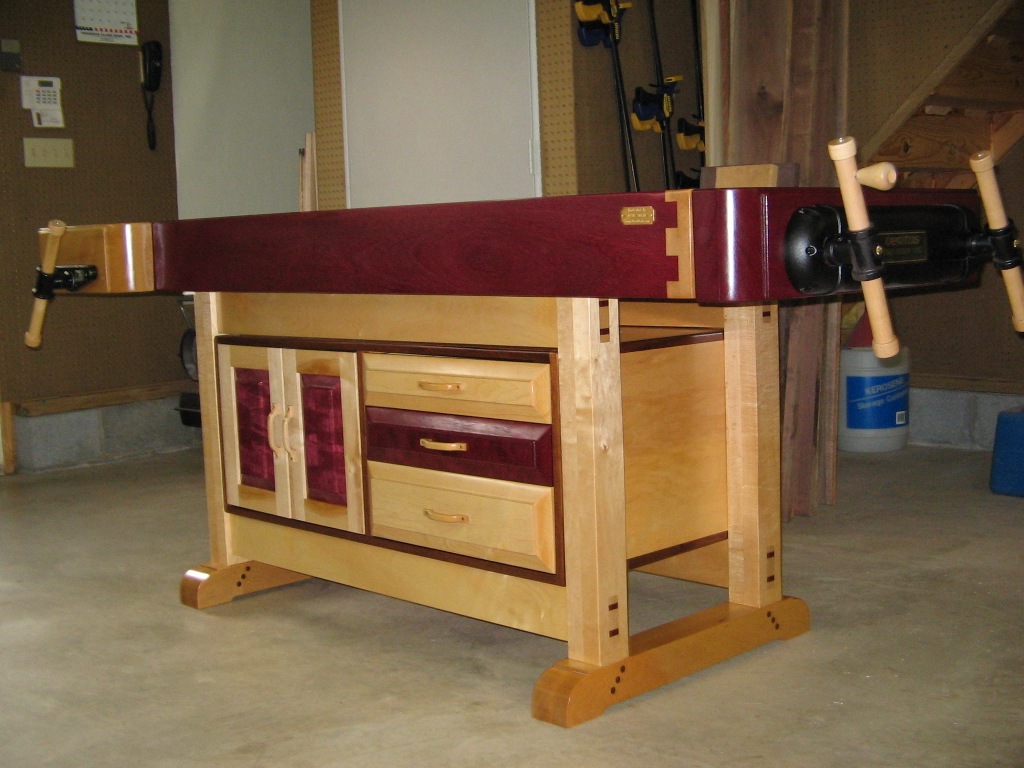J_SAMa
Established Member
Hi all,
After weeks of procrastination, I'm finally starting to design and build my first workbench. It will be a European style one, with an apron, fitted with a front vise and "L" tail vise. I'm posting this here because I've basically only hand tools to work with (and a circular saw for initial preparation maybe), so please take that into consideration.
First of all, long trestle vs. wide apron?
In most European benches I've seen or read about, there are both short trestles that connect the legs along the width and long trestles that run along the length (all of them mortised and tenoned). But it Paul Sellers' design, he simply uses an (very wide) apron attached to the legs by wedges and dadoes to prevent lateral tension from taking place, as shown in this video 11:05:
http://www.youtube.com/watch?v=OyDjZWo3b3U
Well, I understand that a wide apron with dadoes and wedges would tolerate more inaccuracy than M&T'd long trestles do. But would I be compromising much strength and stability by using this design?
And how do I connect the top to the frame?
Again, taking Paul Sellers' design as an example. He simply glues the top on the bearers and aprons, without any joints. I can't see a problem in this but a top glued on with no joint makes me feel inadequate...
I haven't decided on the species of the wood I'm going to use either. So make suggestions if you want to .
.
Thanks
Sam
----------------------------------------------------------------------------------------------------------------------
26/03/2013 Update:
I just made a sketchup model based on Paul Seller's design. I made the following two modifications:
The front apron is not full length, it doesn't cover the furthest 360mm of top on the left side so it's easier for me to fit a vise (I can make the back jaw liner so that it sits flush with the apron).
The stretchers were moved outwards to sit flush with the legs so that there is enough space for me to screw a bolt through the bearer into the top.

Link to the model:
http://sketchup.google.com/3dwarehouse/ ... d&result=4
After weeks of procrastination, I'm finally starting to design and build my first workbench. It will be a European style one, with an apron, fitted with a front vise and "L" tail vise. I'm posting this here because I've basically only hand tools to work with (and a circular saw for initial preparation maybe), so please take that into consideration.
First of all, long trestle vs. wide apron?
In most European benches I've seen or read about, there are both short trestles that connect the legs along the width and long trestles that run along the length (all of them mortised and tenoned). But it Paul Sellers' design, he simply uses an (very wide) apron attached to the legs by wedges and dadoes to prevent lateral tension from taking place, as shown in this video 11:05:
http://www.youtube.com/watch?v=OyDjZWo3b3U
Well, I understand that a wide apron with dadoes and wedges would tolerate more inaccuracy than M&T'd long trestles do. But would I be compromising much strength and stability by using this design?
And how do I connect the top to the frame?
Again, taking Paul Sellers' design as an example. He simply glues the top on the bearers and aprons, without any joints. I can't see a problem in this but a top glued on with no joint makes me feel inadequate...
I haven't decided on the species of the wood I'm going to use either. So make suggestions if you want to
Thanks
Sam
----------------------------------------------------------------------------------------------------------------------
26/03/2013 Update:
I just made a sketchup model based on Paul Seller's design. I made the following two modifications:
The front apron is not full length, it doesn't cover the furthest 360mm of top on the left side so it's easier for me to fit a vise (I can make the back jaw liner so that it sits flush with the apron).
The stretchers were moved outwards to sit flush with the legs so that there is enough space for me to screw a bolt through the bearer into the top.
Link to the model:
http://sketchup.google.com/3dwarehouse/ ... d&result=4







